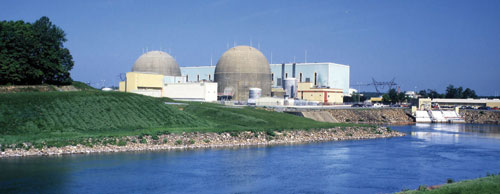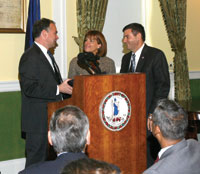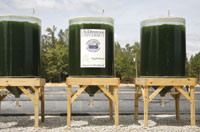Virginia is growing greener every day. The energy industry has taken root in the Commonwealth – from research and development to administrative and legislative action lending support to green industry – and it’s blooming.

And why shouldn’t it? Virginia’s East Coast location makes it an ideal candidate for wind and solar technology. The Commonwealth has a high concentration of energy research at federal labs, universities and private industry. And it already has a force of about 31,000 men and women working in the energy sector today.
In Southwest Virginia, a $1.8 billion coal- and biofuels-powered generating plant is being constructed, a 39 mega-watt wind development facility is about to break ground and fields of wind turbines are being considered nearby.
The country’s first commercial data center to gain Leadership in Energy and Environmental Design (LEED) certification, Premier Technical Services, was built in Virginia’s Shenandoah Valley.
Central Virginia will soon be the home of the country's first major barley-based ethanol facility. Despite a national economic slowdown, Osage Bio Energy is on track for the May 2010 opening of the company’s $160 million plant in Hopewell – a plant that will produce up to 65 million gallons of the alternative fuel, up to 170,000 tons of barley protein meal and 50,000 tons of fuel pellets.
One of Virginia’s biggest economic development projects of 2008 also involved clean energy. In October, AREVA and Northrop Grumman Shipbuilding announced a joint venture to manufacture equipment and pressure vessels for the nuclear industry and provide nuclear engineering services. The new company – AREVA Newport News LLC – blends AREVA’s expertise in the design and construction of nuclear facilities with Northrop Grumman’s infrastructure and experience in large-scale manufacturing. The new venture in Newport News will produce components for the next generation of nuclear power plants.
“In today’s economy, we can turn our energy challenges into opportunity,” said Virginia Governor Timothy M. Kaine. “Our goal is to position the Commonwealth as a leader in alternative energy generation and research and development. By developing a green energy industry here, we will not only move toward a more environmentally responsible approach to addressing our growing energy needs, but we will also help stimulate Virginia’s economy.”
Going Green – Virginia at the Forefront
Virginia started turning green before it became trendy. In September 2007, Governor Kaine released the Virginia Energy Plan, which included goals such as a 40 percent reduction in the rate of energy growth by 2017, and a 30 percent reduction of greenhouse gas emissions by 2025, bringing emissions back to 2000 levels.
 Virginia took another step in December 2008 when Governor Kaine launched the ‘Renew Virginia Initiative,’ which will make Virginia a leader in protecting the environment and energy conservation and efficiency. The initiative includes legislation to reduce Virginia’s dependency on foreign oil, improve the environment and create green jobs. An interagency task force for energy project recruitment was formed as part of the initiative to work with the Virginia Economic Development Partnership (VEDP), the state’s economic development marketing organization, to build Virginia’s compelling case for energy-related businesses. The task force includes other relevant state agencies, university research centers and the support of several well-known federal labs based in Virginia.
Virginia took another step in December 2008 when Governor Kaine launched the ‘Renew Virginia Initiative,’ which will make Virginia a leader in protecting the environment and energy conservation and efficiency. The initiative includes legislation to reduce Virginia’s dependency on foreign oil, improve the environment and create green jobs. An interagency task force for energy project recruitment was formed as part of the initiative to work with the Virginia Economic Development Partnership (VEDP), the state’s economic development marketing organization, to build Virginia’s compelling case for energy-related businesses. The task force includes other relevant state agencies, university research centers and the support of several well-known federal labs based in Virginia.
The launch of Renew Virginia was preceded by a focused, energy roundtable discussion during which Governor Kaine heard from executives representing a wide range of alternative energy generation, energy conservation, and research and development companies. Topics discussed included best practices for corporate and university research and development collaboration, incentives, skill sets needed to attract energy project investment, and factors influencing site location of energy production facilities.
“The Renew Virginia initiative has catalyzed Virginia’s energy stakeholders to ensure that all state programs and policies support our business recruitment efforts in the energy sector, and that has been a huge benefit for us,” said Liz Povar, VEDP director of Business Development. “The Initiative also generated significant knowledge about the location factors that influence energy-related companies’ location decisions. These clients value public policy support for developing the energy market, as well as creating a supportive business climate for operations. The Renew Virginia initiative establishes important new tools to energize the market side of energy technologies as well as the business climate.”
Virginia’s Pro-Business Climate
Virginia is known for its pro-business climate. For the last three years, Forbes.com ranked the Commonwealth the “Best State for Business” thanks to lower operating costs and the benefit of connecting to the world economy through its international airport and seaport systems. Companies enjoy a stable 6 percent corporate income tax that hasn’t increased since 1972, property tax exemptions and one of the lowest combined state/local/use taxes at 5 percent.
 Virginia has a number of energy sector business incentives. It has a Solar Manufacturing Incentive Grant Program that offers up to $4.5 million per year to encourage the production of photovoltaic panels in Virginia. There is also a Biofuels Production Incentive Grant Program at 12.5 cents per gallon for advanced biofuels and 10 cents per gallon for standard biofuels and a Clean Fuel Vehicle Job Creation Tax Credit of up to $700 per new job.
Virginia has a number of energy sector business incentives. It has a Solar Manufacturing Incentive Grant Program that offers up to $4.5 million per year to encourage the production of photovoltaic panels in Virginia. There is also a Biofuels Production Incentive Grant Program at 12.5 cents per gallon for advanced biofuels and 10 cents per gallon for standard biofuels and a Clean Fuel Vehicle Job Creation Tax Credit of up to $700 per new job.
Another statement of Virginia’s commitment to the energy industry is a $40 million contribution by The Virginia Tobacco Indemnification and Community Revitalization Commission toward the funding of five regional energy research centers. The centers will focus on everything from biofuels and nuclear power to clean coal technology. The Tobacco Commission plans to contribute another $53 million for energy R&D projects in FY2010, the first installment of what is planned to be a $100 million commitment over the next three years. A timeframe for accepting project proposals will be announced when guidelines are approved by the Commission in August.
The Commonwealth will leverage the American Recovery and Reinvestment Act (ARRA) funding to grow its energy business even more. This funding includes $94 million for weatherization programs and efficiency and conservation grants, $76 million for the Virginia Energy Program, and $54 million in Energy Efficiency and Conservation Block Grants to localities.
Energy research and development is also a major focus of Virginia’s strong higher education community. More than a dozen colleges and universities are studying everything from wind and solar energy to transforming algae into biofuel. These world-class universities will be strong competitors for ARRA grants.
Virginia – Positioned to be a Leader
“Virginia is positioned to be a leader in the energy industry,” Governor Kaine said. “Over the past 23 months, Virginia has attracted energy related projects resulting in an additional 2,450 attractive jobs and $2.4 billion in capital investment. I am confident that we can build upon and accelerate the Commonwealth’s energy project attraction and business section.”
Virginia ’s energy project wins, combined with the strategies in place to address energy efficiency and energy conservation, help position the Commonwealth as a best-in-class leader in alternative, supplemental energy generation and research and development.
For more information about doing business in Virginia, please visit: www.YesVirginia.org.

